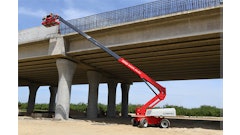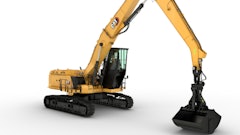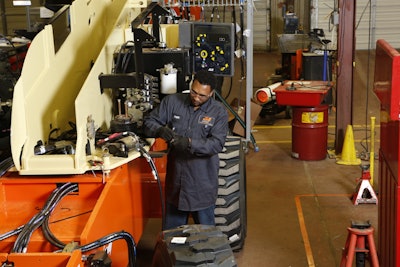
A shortage of qualified service technicians has plagued the construction and rental industries for the past 25 years or more, potentially jeopardizing the productivity and safety of machines that offer the safest means of performing work at height. While significant focus has been put on training operators on the safe use of aerial work platforms, there’s room for a deeper discussion about how to ensure service techs start with a strong foundation of education and experience and then continue to receive the ongoing training they need to stay up to date with the latest technology. What can the industry do to raise awareness of the need for properly trained and qualified service techs? What are the current training requirements and how do we know if they’re being met? We asked several industry stakeholders for their opinions on these questions and more. Following is an excerpt from that discussion.
Jenny Lescohier, editor of IPAF Elevating Safety: What are the current training and qualification requirements for those who service aerial work platforms?
Bob Bartley, senior director of product support and reconditioning at Genie/Terex AWP: According to the current ANSI A92 standards, as well as the upcoming changes to the CSA B354 standards, users (defined as employers or company owners) must ensure that maintenance and repair personnel are trained by a qualified person to inspect and maintain AWPs in accordance with the manufacturer’s recommendations and ANSI and CSA standards.
Tony Groat, manager of IPAF in North America: Within those standards there are also requirements for manufacturers and other entities to assist in this process. According to the standards, manufacturers have an obligation to provide materials to aid dealers, owners and users. Owners selling equipment have a responsibility to provide support to the entity buying the equipment in meeting their responsibilities defined in the standards. Dealers have the responsibility to provide support to users of the equipment. While the ultimate responsibility to make sure employees are qualified rests with the employer, other entities have responsibilities in the process.
Lescohier: How do fleet owners, such as rental companies, handle getting techs the training they need?
Jake Kidd, safety training manager at Sunstate Equipment Co., LLC: We are in good communication with the manufacturers and take advantage of the training they offer. Quite often they’ll travel to our facilities to conduct training and we’re very willing to send people to whatever training that’s available, along with mentorship programs, while they’re learning the ropes. We have our own internal criteria for the advancement of our people that tells us, okay he was at this level two years ago, and now he’s at this level due to experience and the type of work successfully completed.
Training by any means necessary
Lescohier: Many smaller rental companies only employ one person to do all the maintenance on all of their equipment. When personnel are that busy, how can a rental company ensure they take the necessary time to be properly trained and qualified?
Teresa Kee, director, environmental health and safety at NES Rentals Inc.: We’ve used manufacturers’ online training programs. That’s a good avenue for smaller rental companies with limited personnel resources.
Rick Smith, senior director, global product training at JLG Industries Inc.: With online programs, you can easily get training in the hands of a single technician. JLG does offer regional training, but it can still be a challenge to send the one person who services an entire fleet.
Taking it to the next level
Lescohier: Should there be different levels of qualification based on size or complexity of equipment?
Smith: It really is task dependent. If you take your car to an oil change facility, those techs need to know how to change oil and check basic fluid levels, but they’re not going to do engine diagnostics. It depends on what you expect from your technicians. If you expect them to make full repairs on any part of a machine, then I believe there should be different levels.
Bartley: The question isn’t only about qualifying a technician to be able to repair a machine, it’s also about qualifying any technician on how to properly perform an annual inspection. We don’t want to end up where you have two classifications; where you have someone who can only perform an annual inspection, and not perform repairs. You end up with two completely separate people where the knowledge base should be combined. Especially when you get to larger units. It’s one thing to perform an annual inspection on a scissor lift, but when you get to machines that are more complicated, they need to be able to do both. Different levels of qualifications need to come in.
Giles Councell, director of operations at IPAF: One aim of developing a skills framework is to identify different career stages for service technicians, and to determine what qualifications they need to be able to perform in those stages, from performing an annual inspection to actually repairing the machine.
Smith: I would agree. That also provides a service technician with a career path. They start at the entry level and then they have a future. If a job is limited to inspection only, they’re going to get tired of that and go someplace else.
Lescohier: What are the obstacles in getting individuals the qualifications they need?
Ian McGregor, director of product safety at Skyjack Inc.: There’s difficulty in ensuring individuals are allowed the time away from day-to-day tasks to gain the knowledge they need. Manufacturers typically offer technical training at the facility or branch, but service techs might be called away for breakdowns or service calls that don’t allow for that training to occur. Another obstacle is with the employers or service techs not realizing what specific training and literature resources are available from the manufacturer.
Kee: There’s such a variety of equipment the mechanics work on and the equipment is always changing. We need to help them to be able to manage all those different types and stay current.
It’s a long-term commitment
Lescohier: What can the industry do to ensure people get the necessary qualifications?
Smith: When somebody comes to JLG training, they’re checked off, they’re qualified, they’ve been trained… but they need to apply what they’ve learned to their day-to-day job. If you attend our training on a boom lift, and you only work on scissors, you’re going to lose that boom knowledge quickly. There’s a real need for a commitment to follow-up in the shop.
There’s a lot of resistance to prerequisites in training programs, but in order to ensure a person is prepared to learn about a more complicated machine, they need to have fundamental skills. One of the things we can do as an industry is commit to the training programs that manufacturers provide, including the prerequisites and our recommended learning paths.
Lescohier: How do we motivate people to take the time?
Groat: Most learning takes place in on-the-job training. But what is required for on-the-job training? What are those elements that need to be checked off for entry level, for intermediate, for master techs? That’s really where we as an industry can fill in the blanks and offer guidance. You can’t get where you want without a good road map to follow.
Lescohier: Should training expire after a certain period of time? Should recertification be necessary?
Kidd: Most mechanics I know possess general aptitude. As new machines come out, they intuitively go and check them out. They kick the tires, review the maintenance manual, and when it’s time to service it, they have an idea of what they need to do. Certainly, a shop foreman needs to ensure additional training goes on. But it depends on the employer; only they can make that decision based on their daily observation, and the individual’s track record. To say a tech needs to re-up every year, I’m not sure that’s necessary if he’s been in the industry bettering himself on a daily basis with repetition and continuous work.
Councell: There is some need for verification that that person is still able to perform their role if there’s been any new technology. We need to at least identify opportunities to monitor development throughout a service tech’s career to ensure everyone is still aware of new technology. That could be monitored by the employer.
McGregor: When there is significant change to designs and updates to new technology, or if you have a change in the brand of equipment found in the fleet, continuous development would be necessary to ensure the technician is qualified for the machines they’re working on.
Kee: Technicians can get complacent on some of the tasks they’re constantly performing. Periodically pulling them out and reminding them of the right way to do something is a good idea because they could have picked up some bad habits along the way. It’s important to get a feel for the individual mechanic and their number of years of experience. It’s such a challenge to quantify their abilities and their experience and be able to set a criteria and say this person can do this job.
Councell: As an industry we can set that framework and give guidance on how to monitor it through the person’s career, set milestones they should achieve and assess if they’ve achieved them.
Risks of being underqualified
Lescohier: What are the primary risks when service techs are underqualified but still performing the service?
Bartley: Operator safety is the number one priority each and every time someone gets into a piece of aerial equipment. Equipment operators depend on the aerial lift to work and function properly and safely every time they use it, for every job they do. But training goes beyond the operators. We also need to have technicians properly trained to work on, repair and maintain the equipment because machines that receive the right care will run smoother, enhancing productivity on jobsites, while helping keep operators safe. To make service and maintenance work more efficiently and help reduce downtime, technicians need to demonstrate proficiency in the ability to calibrate, adjust and troubleshoot with the aid of available tools such as schematics, service manuals, laptop or table and connection software.
A qualified technician not only knows how to read the equipment schematics and how to do the repair, they also know how to get the repair done in the least amount of time with a minimal amount of parts expense. This translates to less downtime for the machine and a higher return on investment for the company.
Smith: There are significant customer satisfaction issues too, resulting from underqualified service techs.
Groat: In addition to the primary concern for safety, there’s the cost of losing a customer because the equipment is down. Sometimes the customer’s downtime eclipses the cost of the rental. I’ve fought that battle before, when you rent an AWP out for $2,000 a month and they want to back charge you $10,000 for the loss of the day due to downtime.
Help wanted
Lescohier: Any thoughts on what we can do to cultivate more qualified service techs in the industry?
Councell: One of the challenges is promoting that there’s a career here and what the path is to get there. Once we create a path and determine how to get to the top level, then the industry can start promoting it as a career.
Groat: A lot of people have lived good lives being part of this industry – manufacturers, distributors, rental companies, and users of equipment. AWPs are making access to work at height much safer and productive and it’s still a growing industry. We need to take a marketing approach to this and say not all kids are going to be doctors and lawyers. Filling the positions in this industry is a responsibility that we should be taking on. We have an opportunity to build this career path and help people look at this as an opportunity to succeed.
Post script: What does this mean to contractors?
“A mechanic should able to work on any equipment” is a dangerous assumption. If you own an AWP/MEWP, you are responsible to have personnel who are qualified to work on that specific type of AWP/MEWP or one having similar design characteristics. Being a mechanic on other types of equipment is not the qualification required to inspect, maintain and repair various types of aerial equipment. Do not send your owned equipment to companies that repair your other equipment, unless they are qualified to work on aerial lifts. If those repairing the equipment do not have a relationship with the manufacturer, access to required service and parts manuals and possible manufacturer’s bulletins could be missed. If you rent equipment, know that unless your personnel are qualified to maintain and service the equipment, they should not be doing this task. Instead, contact your rental provider to perform the necessary task. If you have any questions about the qualifications of your personnel, ask your equipment manufacturer or supplier for guidance.




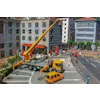
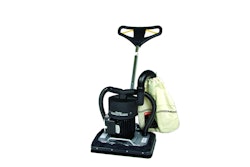
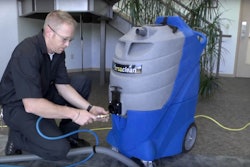
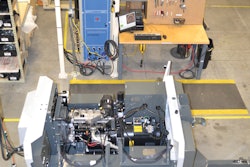
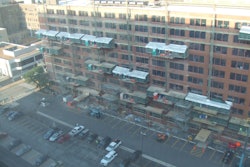
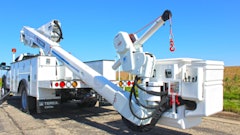

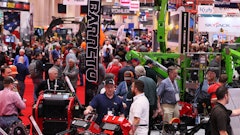


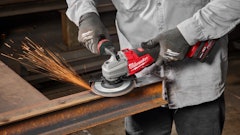
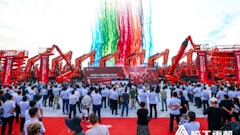

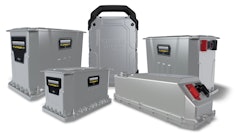

![Building Angled Sm Edit 6050b8d213f1b[1]](https://img.forconstructionpros.com/mindful/acbm/workspaces/default/uploads/2025/09/building-angled-sm-edit6050b8d213f1b1.Ygq5aAos3b.png?ar=16%3A9&auto=format%2Ccompress&crop=focalpoint&fit=crop&fp-x=0.53&fp-y=0.23&fp-z=2&h=135&q=70&w=240)
